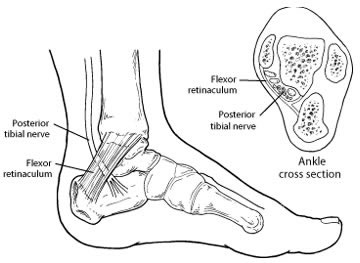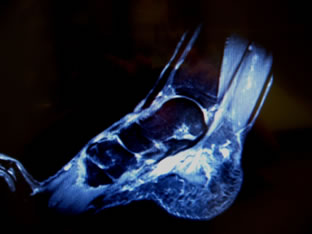Tarsal Tunnel Syndrome (TTS)
The tarsal tunnel is a narrow space that lies on the inside of the ankle. Covered with a thick ligament (the flexor retinaculum) it provides protection to the nerves (Tibial and Plantar nerves), arteries and veins to the foot. If the tunnel becomes tight or crowded, the nerve gets squashed causing pain and numbness.
Similar to carpal tunnel syndrome which occurs in the wrist, the symptoms are produced by compression or squeezing on the tibial nerve, producing pain anywhere that the nerve supplies - Commonly the heel and the sole of the foot.

Symptoms
- Commonly tingling, burning, or numbness in the sole of the foot
- Pain or cramp in the sole of the foot
- Occurs at night, with exercise and at rest
- Heel pain, identical to plantar fasciitis – its a rare cause of prolonged heel pain.
If left untreated, the condition can get worse and may result in permanent nerve damage. Because the symptoms of tarsal tunnel syndrome can be confused with other conditions such as Plantar Fasciitis, proper evaluation to assess nerve involvement is essential so that a correct diagnosis can be made and appropriate treatment initiated.
Causes
Tarsal tunnel syndrome (also known as posterior tibial neuralgia) is caused by anything that produces compression on the posterior tibial nerve, such as:
- The most common cause is varicose veins in the tarsal tunnel
- It is also caused by anything that might crowd the tunnel such as a cyst or ganglion, an arthritic bone spur or inflamed tendon.
- Flat feet are a contributory factor, because the outward tilting of the heel that occurs with "fallen" arches can produce strain and compression on the nerve.
- Systemic diseases such as diabetes or kidney disease make the nerves more susceptible to injury
- Systemic hormone imbalance eg hypothyroidism can also cause this.
Diagnosis
The most important thing is to find out what the cause is and treat this correctly.
Your foot is examined for any loss of feeling and during this examination, the nerve can be tapped with the foot in various positions to see if the symptoms can be reproduced.
MRI imaging studies may be required if an obstruction is suspected and modern MRI scanners provide a very detailed view and often a definitive diagnosis.
Nerve conduction studies – a painless way to test the nerve circuitry. It is not always

MRI showing very bright benign tumour of the tibial / medial plantar nerve
Non-surgical Treatment
Its most important to treat the underlying cause. More often than not, no cause is found even with MRI scans and Nerve studies.
Ultrasound guided steroid injections – these may relieve the pain temporarily or even permanently.
In the case of varicose veins, having these treated by a vascular surgeon may cure the problem.
Tarsal Tunnel Nerve Release Surgery
Usually surgery is necessary to release the squashed nerve.
A small incision is made behind the ankle bone and then down towards but not quite as far as the bottom of foot. This is very delicate and precise surgery. The sheath overlying the nerve and forming the roof of the tunnel is divided, with great care to avoid any injury to the Tibial nerve and the main artery beneath. The nerve is carefully separated from the adjoining artery and vein and then followed into the tunnel. It has several fine branches, (medial calcaneal nerve, 1st branch of the lateral plantar nerve, medial and lateral plantar nerves) which are each individually examined and released from any tight tissues. The nerve is then released from the causes of the compression and any cysts or other space-occupying problems corrected at this time.
The skin in this area is very delicate and so it is very important to keep the leg well elevated following the surgery to prevent the wounds breaking down and further injury to the nerve.